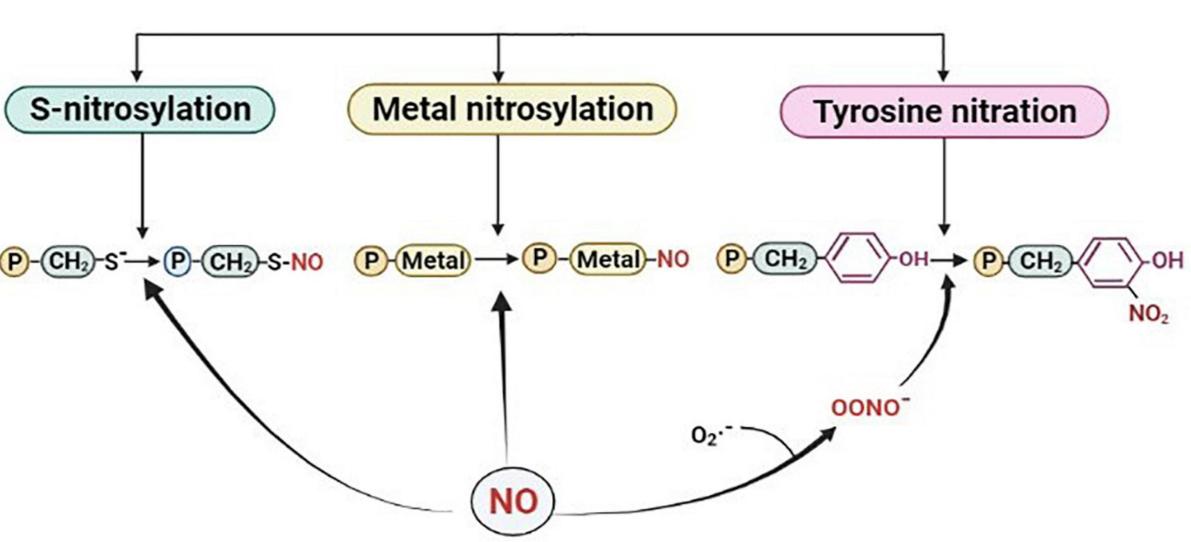Nitrosylation Analysis Service
Protein nitrosylation is an ancient and pervasive type of protein modification that has accompanied the evolution of life and cannot be ignored as a key factor in a wide range of life processes. Creative Proteomics offers high-quality nitrosylation analysis services, including identification, quantification and characterization of protein nitrosylation modifications, providing valuable insights into your protein research.
What is Nitrosylation
As a second messenger, NO affects cells in two ways. One is the cGMP signaling pathway and the other is nitrosylation (or S-nitrosylation). It is a redox-based post-translational modification of proteins in which the NO group is covalently linked to the cysteine sulfhydryl group (S-terminus) of the protein to form nitrosothiols, thereby altering protein conformation, stability, subcellular localization, and activity. Nitrosylation has a short half-life in the cytoplasm due to denitrosylation by reductases; therefore, nitrosylation is usually protected in the folding of plasma membranes, vesicles, and lipophilic proteins.

Fig.1 Schematic of nitrosylation (Pande, A. et al.; 2022)
Nitrosylation is a reversible PTM found widely in cell signaling and has essential biological functions. Nitrosylation affects the biological activity of many enzymes (like caspases) and is also related to the onset and progression of many diseases (e.g., AD and PD). Nitrosylation analysis allows for a detailed examination of proteins, providing insight into the dynamics and biological significance of protein nitrosylation.
Applications of Nitrosylation Analysis
- Cellular Signaling
Protein nitrosylation is a key player in cellular signaling pathways, influencing processes such as vasodilation, neurotransmission, and apoptosis. It contributes to understanding how nitrosylation events participate in these signaling cascades. - Redox Regulation
Nitrosylation is intricately linked to redox regulation in cells. It aids in deciphering how nitrosylation contributes to the redox balance and how alterations in nitrosylation patterns may impact cellular homeostasis. - Disease Mechanisms
Aberrant protein nitrosylation is associated with various diseases, including neurodegenerative disorders, cardiovascular diseases, and cancer. It contributes to uncovering altered nitrosylation patterns as potential biomarkers or therapeutic targets.
Our Service
Creative Proteomics has advanced protein detection technologies and can provide customized services to researchers and scientists to help them reveal the complexity of PTM using powerful mass spectrometry technologies. Our services are thoughtful and detailed and the process of nitrosylation analysis service is as follows:

Fig.2 Nitrosylation analysis workflow
- Sample Preparation
Proper extraction and preparation of proteins from biological samples to ensure preservation of nitrosylated proteins. - Nitrosylation Enrichment
Enrichment techniques are employed to isolate nitrosylated proteins or peptides. This step is crucial as nitrosylation modifications are often present in low abundance compared to unmodified proteins. - Detection
WB, protein microarrays and LC-MS/MS are powerful tools for the identification and quantification of nitrosylated peptides, and they provide detection information that facilitates a comprehensive analysis of nitrosylation. - Bioinformatics Analysis
Advanced bioinformatics tools are used to analyze data, identify nitrosylated peptides, and map these modifications to protein sequences. - Result Delivery
After professional data analysis, we deliver results quickly and consistently.
Creative Proteomics brings a wealth of experience to the field of protein research. Our comprehensive services and products cover the entire spectrum of utilizing suitable and efficient gateways. Utilizing our proprietary platform, we have successfully implemented many proteomics research projects. If you are interested, please contact us for more information and a quote.
Reference
- Pande, A.; et al. Phytohormonal Regulation Through Protein S-Nitrosylation Under Stress. Frontiers in Plant Science. 2022, 13: 865542

